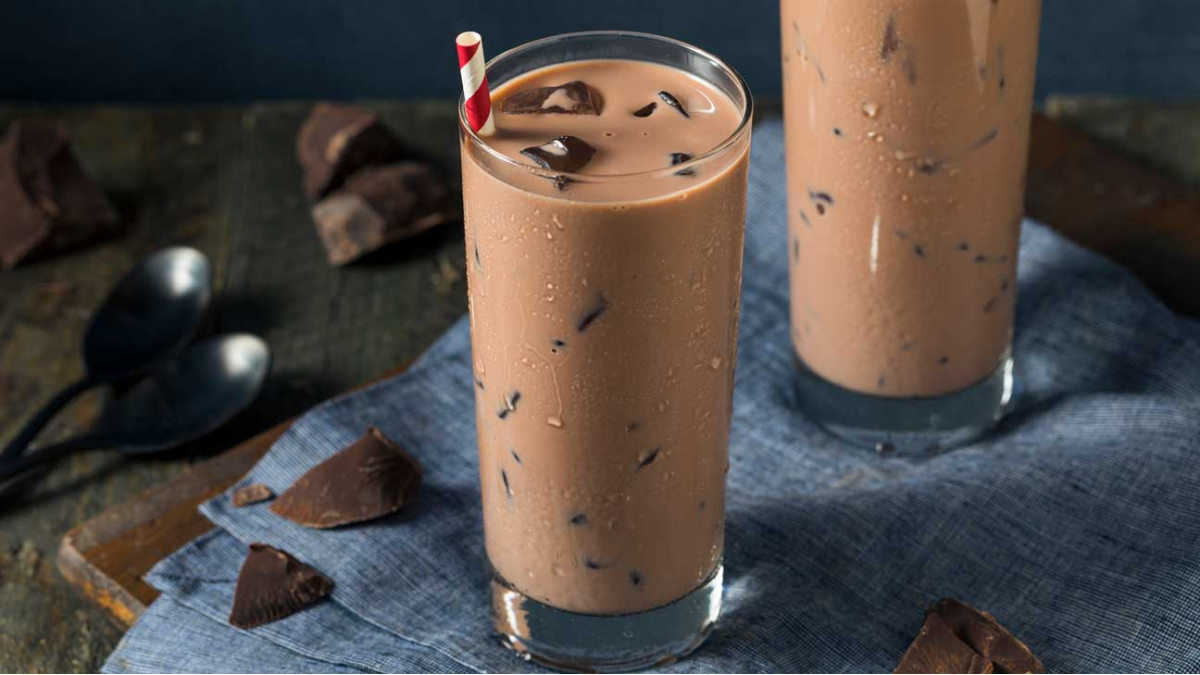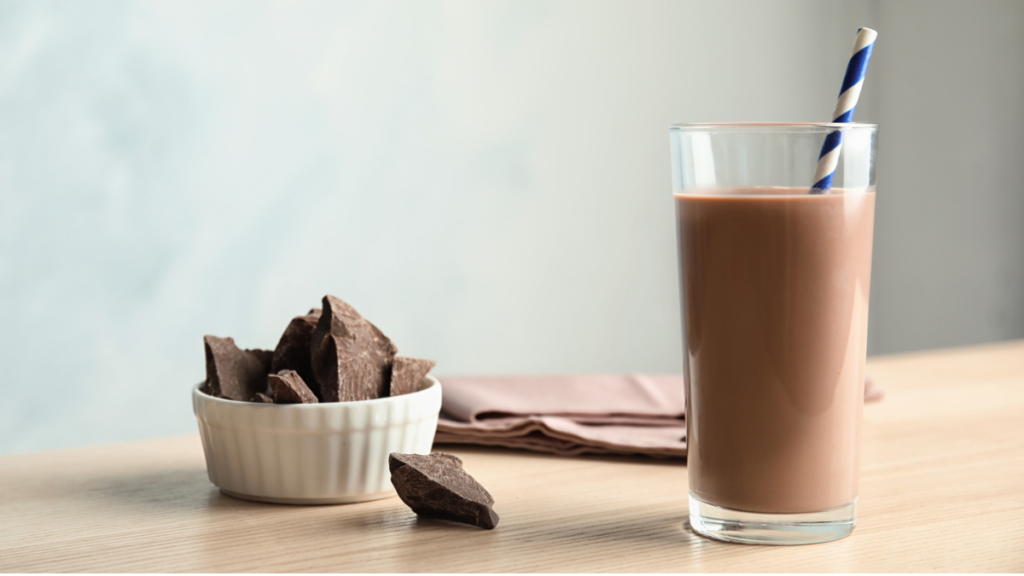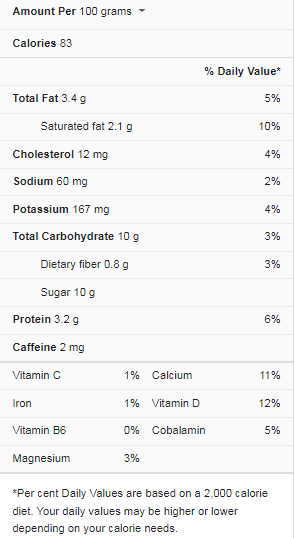Chocolate milk, whether served hot or cold, is more than just a childhood favorite drink for many individuals. It’s also high in several essential nutrients. It also has a lengthy and fascinating past. The scientific name for chocolate is Theobroma cacao, which means “food of the Gods.” It was pounded into a powder, blended with spices, water, and sometimes honey, and drunk by the Aztecs. Early on, the transition from chocolate water to chocolate milk occurred. People in Jamaica drank “a hot beverage… from shavings of newly harvested cacao, cooked with milk and cinnamon as early as 1494, according to historian James Delbourgo. To Know chocolate milk nutrition facts, read further.
Chocolate milk satisfies your hunger, leaves a delectable taste on your lips, and still has some nutritious value. It’s an excellent post-workout drink to include and have on hand. After your workout, reach for a glass of water to rehydrate your body and satisfy your hunger. Because it’s so good, this is a drink and a habit you’ll want to stick to! Chocolate milk has a bad reputation, but it’s good for you! If you’re a fitness fanatic, who needs a great post-workout drink, grab an ice-cold cup of chocolate milk and enjoy the sweetness.
What is Chocolate Milk?
Chocolate milk is simply a sweetened chocolate-flavored version of regular white milk. It has been around since the 1700s in some form or another, and there are many different ways to make this creamy and delectable drink. While some parents are wary of flavored milk like chocolate milk, it has proven to be a healthy and refreshing beverage. While it has more calories and sugar than white milk, it also has a higher concentration of some nutrients. Most experts agree that chocolate-flavored milk is a healthy part of a balanced diet.
Chocolate Milk Nutrition Facts
Chocolate Milk’s Health Benefits
It has several health benefits, including restoring nutrients after exercise, managing growth, improving bone density, activating the immune system, and regulating digestion. The nutritional profile differs depending on whether you use whole milk, 2% milk, or skim milk. An 8-ounce portion of chocolate milk made with whole milk, for example, contains: The fat and calorie levels aren’t the only things that differ. Whole milk contains more protein and fewer carbohydrates. As a result, it is based on both your personal preferences and your dietary goals.
1. Improves Recovery
Many athletes praise this sweet milk variant as an ideal post-workout recovery beverage. It can supply carbohydrates, proteins, vitamins, and electrolytes in a tasty form that is great for muscle building and toning.
2. Bones are Strengthened
Chocolate milk is an excellent choice for youngsters (in moderation) because it has a high protein content and is simpler to persuade them to drink chocolate-flavored milk. Because of the high calcium and vitamin D content, this will ensure optimal growth and development and strong bones. Many people believe that milk is only beneficial to children because it helps them develop strong bones. However, milk is beneficial to the health of your skeleton at any age. Although we generally consider bones static after we reach maturity, they are dynamic tissue constantly torn down and replaced.
The rate at which bone is broken down, on the other hand, begins to outstrip the rate at which new bone is created as you get older. Calcium can be found in abundance in milk. According to the National Institutes of Health (NIH), bones and teeth contain 99 percent of the body’s calcium. “The body uses bone tissue as a storage for and supplier of calcium, to maintain stable calcium concentrations in blood, muscle, and intercellular fluids,” according to the study.
3. Immunity Booster
Chocolate milk, which has many vitamins and minerals, including vitamin C, can help the immune system fight infection and disease.
4. Controls Blood Pressure
A single cup of chocolate milk has more than 10% of the daily potassium requirement, which can help decrease blood pressure and enhance heart health by reducing the risk of heart attacks and strokes. Hypertension (high blood pressure) is a prevalent problem in the United States. According to the Centers for Disease Control and Prevention (CDC), 108 million Americans have high blood pressure, yet only 24% have it under control. Heart disease and stroke, which kill hundreds of thousands of people each year in the United States, are linked to high blood pressure.
Although most discussions about decreasing blood pressure through diet centers limit salt intake, milk drinking may also be beneficial. The mineral component of milk may contribute to its capacity to reduce blood pressure. Staci Nix McIntosh, a registered dietitian and assistant professor at the University of Utah, stated, “Calcium, magnesium, and potassium, in particular, are minerals that help reduce, or maintain, a low blood pressure.” She pointed out that while milk is known for its calcium content, it also includes large levels of the other two minerals. Milk proteins may also be useful.
5. Enhances Digestion
Chocolate milk contains a lot of fiber, which helps to promote digestion and regulate bowel movements while also reducing bloating, cramping, and indigestion.
6. Muscle Repairing Protein
Pour yourself a glass of chocolate milk after a workout if you want to incorporate chocolate milk into your diet in a healthy way. This is when you may begin to notice the drink’s advantages. Your muscles, for example, are strained and ripped after an exercise. Chocolate milk contains enough protein to help mend these injured muscles and prepare them for activity the next day. It will mend, develop, and build muscles while gratifying your sweet craving and stomach.
According to the National Institutes of Health, adults should get roughly 1,000 mg of calcium each day, depending on their age, sex, and pregnancy or breastfeeding status. Depending on the fat level, a cup of milk contains 276–299 mg. Vitamin D, which is required for normal bone formation and remodeling, is frequently added to milk.
7. Carbohydrates as a Source of Energy
You’re undoubtedly exhausted after a workout, and this is because you depleted your energy reserves to complete your workout. Chocolate milk has a good amount of carbs, and these carbohydrates can swiftly refill your energy supply. This means you’ll have plenty of energy to finish your day and even work out again if you want to.
8. Electrolytes and Rehydration
You sweat and deplete your water supply during an exercise. Drinking a glass of chocolate milk can assist in rehydrating and avoiding dehydration while also providing electrolytes to the body. Electrolytes assist the body in gaining much-needed energy as well as preventing dehydration. These are the same things you’d get from a sports drink, but drinking chocolate milk is more natural and delightful to keep your body fueled.
9. You May Lose Weight
Even though a glass of milk doesn’t exactly scream “diet food,” research suggests that drinking milk daily may help you lose weight. Participants on a high-milk diet (three cups of low-fat milk daily for eight weeks) lost considerably more weight than those on soy milk, calcium supplement, or control diets, according to a 2011 study published in Nutrition, Metabolism, and Cardiovascular Diseases. On average, milk drinkers lost 4.43 kg (9.77 lbs), whereas the control group lost only 2.87 kg (6.33 lbs). Milk appears to help inhibit hunger cues, which is one reason why it may help you lose weight.
Obese women were followed for six months on a calorie-restricted diet in a Cambridge University Press study released in 2010. The milk supplement was given to half of the participants, while the placebo was given to the other half. According to the study, those who consumed milk felt less hungry and had a “lower rise in the desire to eat” during their diet. They also showed a smaller drop in feelings of fullness than the control group while on a diet.
Is Chocolate Milk Safe to Drink daily?
In comparison to conventional milk, Chocolate milk contains extra sugars and calories, both of which can contribute to obesity, which can lead to a variety of medical problems. This isn’t the ideal option if you’re trying to keep your sugar and calorie intake in control. Due to its sugar content, this beverage may provide some benefits to your muscles and bones, but it may also promote illnesses like heart disease in adults and obesity in children.
As a result, chocolate milk should be drunk in moderation as a once-in-a-while pleasure rather than regularly. Chocolate milk contains nine vital elements that everyone requires. Chocolate milk is helpful for your approach to a nutritious diet because it contains 8 grams of natural, high-quality protein and bone-building minerals like calcium, vitamin D, and phosphorus.
Is Chocolate Milk Healthier than White Milk?
While chocolate milk has more carbohydrates per serving than white milk, both include the same nine key components and can be a great post-workout drink. This is why: White or chocolate milk is 90% water and a delicious post-workout beverage. Chocolate milk, unlike water and many commercial sports beverages, has naturally occurring protein that aids in muscle repair and regeneration. It also contains fluids and electrolytes to help you rehydrate and replace what you’ve lost via sweat.
Some studies suggest that milk, rather than water, may help you keep hydrated after exercise. Calcium, which is needed for strong bones, can be found in milk chocolate. It also contains more antioxidants than white chocolate and less fat and sugar, making it a healthier option. Chocolate milk has extra sugars, which means it has more calories, contributing to an increase in overweight and obesity. In the United States, one-third of children are overweight or obese, putting them at risk for chronic diseases including type 2 diabetes, heart disease, and cancer.
Is Chocolate Milk Beneficial to the Brain?
In addition to improved memory, the study found indicators of increased function in the brain’s hippocampus, confirming the idea that cocoa flavanols promote blood flow in the brain. Professor Ian Macdonald’s research discovered that drinking cocoa high in flavanols, a major element in dark chocolate, improves blood flow to important brain locations for two to three hours. According to experts, after an exercise, you should take 15 to 25 grams of protein, which equals 500 to 750 milliliters of chocolate milk.
It has twice the carbohydrate amount of ordinary milk, water, or most sports drinks, making it great for tired muscles. Plus, chocolate milk is a far healthier option than sugary sodas and fruit beverages devoid of nutrients.” The significant levels of beneficial antioxidants and polyphenols naturally found in cocoa are stripped away in the alkalized cocoa used in commercial chocolate milk.
Is Chocolate Milk High in Sugar?
The chocolate milk in the sample above has 6g of added sugar and 24 calories. Chocolate milk would provide needless extra calories for the average inactive individual compared to white milk, but that does not make it. It helps muscles recover rapidly after a strenuous workout by replenishing water and essential nutrients lost through sweat. Chocolate milk in a well-balanced post-workout meal can help mend and rebuild injured muscles.
No, milk does not make you grow taller, as far as current science can tell, because nothing can make you grow taller. On the other hand, milk can be an effective aid in assisting children in reaching their full height potential. Chocolate milk is rich in protein, calcium, vitamins A and D, B-12, riboflavin, phosphorus, magnesium, zinc, and other nutrients.
Conclusion
Many people prefer to create their chocolate milk instead of buying it at the store, which is a straightforward process. Blending chocolate or sweetened white milk makes a chocolate drink. The majority of individuals stir chocolate syrup or chocolate powder into milk. To make a richer or creamier version, other ingredients may be added to pre-packaged chocolate mixes. Melted chocolate can also be used based on your preferred sweetness and sugar intake. Take a look at the recipe that follows.



